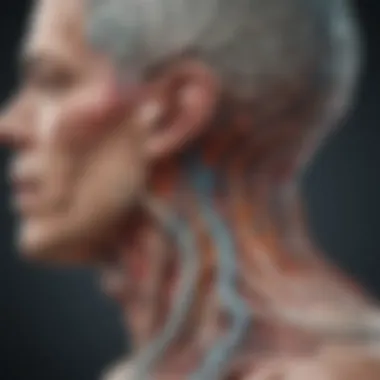Exploring the Vagus Nerve: Functions and Health Implications


Intro
The vagus nerve, a major player in the autonomic nervous system, often goes unnoticed despite its profound effects on the body and mind. This article aims to unravel its contributions, exploring its functions and implications in health and mental well-being. Understanding the vagus nerve opens the door to numerous insights about how our body operates and communicates internally.
Research Highlights
As research into the vagus nerve progresses, key findings have emerged that emphasize its importance in various physiological processes. Notably, studies have shown the vagus nerve's central role in regulating heart rate, digestive functions, and immune responses.
Key Findings
- Autonomic Regulation: The vagus nerve plays a critical role in the parasympathetic nervous system, helping to lower heart rate and promote digestion.
- Mental Health: Recent findings indicate a strong connection between vagal tone and mental health conditions, such as anxiety and depression.
- Clinical Applications: Applications for vagus nerve stimulation are being explored for various medical issues, pointing to its potential therapeutic effects.
The vagus nerve influences several body functions, making it a significant focus for both medical research and therapeutic interventions.
Implications and Applications
The implications of these findings for clinical practice and personal health are substantial. For instance:
- Vagus nerve stimulation is being trialed as a treatment for epilepsy.
- Enhanced vagal tone may offer benefits for stress management and emotional regulation.
- Awareness of vagal nerve health can encourage lifestyle changes, such as breathing exercises and mindfulness, that foster overall well-being.
Methodology Overview
To understand the vagus nerve's complexities, researchers employ various methodologies, ensuring a comprehensive approach.
Research Design
The research often utilizes a combination of qualitative and quantitative methods. Randomized controlled trials are common, as well as case studies, to assess different interventions related to vagal activity.
Experimental Procedures
Each study may involve:
- Measurement of heart rate variability as a marker of vagal tone.
- Assessments of participants’ psychological states through validated questionnaires.
- Neuroimaging techniques to observe changes in brain activity linked to vagus nerve stimulation.
This exploration serves as a foundation for further studies, ultimately aiming to deepen our understanding of the vagus nerve and its far-reaching implications. Gradually, as more data surfaces, the role of the vagus nerve will likely become clearer, illuminating pathways for improved health outcomes.
Anatomy of the Vagus Nerve
Understanding the anatomy of the vagus nerve is crucial for grasping its vast array of functions. The vagus nerve, the tenth cranial nerve, is one of the most extensive nerves in the body. It plays a vital role in the autonomic nervous system, impacting both the parasympathetic and sympathetic divisions. Knowing its structure helps illustrate how it communicates with various organs and systems, directly influencing physiological behaviors. The anatomy provides the foundation for understanding its clinical significance and the mechanisms through which it can be manipulated for health benefits.
Origin and Structure
The vagus nerve originates from the medulla oblongata in the brainstem. This area is pivotal as it regulates many involuntary functions crucial for survival, such as heart rate, breathing, and digestion. The nerve's structure includes motor and sensory fibers, which makes it unique. The motor fibers control the actions of the larynx and pharynx, while the sensory fibers convey information about the body's state to the brain.
The vagus nerve has a complex configuration, with a lengthy course extending from the brain to the abdomen, branching extensively along the way. Each branch has specific functions, influencing regions such as the heart, lungs, and digestive tract. This intricate design allows the vagus nerve to maintain a critical role in homeostasis.


Pathways and Branches
The pathways and branches of the vagus nerve outline its extensive reach throughout the body. After leaving the cranial cavity, the nerve descends through the neck, where it branches into cervical branches that control the heart and lungs. The cardiac branches primarily affect heart rate and rhythm, demonstrating the nerve’s impact on cardiovascular health.
As the vagus nerve progresses into the thorax and abdomen, it further divides into numerous branches that affect the gastrointestinal system. The gastric and celiac branches play essential roles in promoting digestive processes, such as enzyme secretion and gut motility. This comprehensive network underscores how essential the vagus nerve is for integrating bodily functions and responding to stressors and changes in the environment. It also highlights why understanding its anatomy is fundamental for various medical interventions.
"The vagus nerve is not just a highway of nerves; it's a critical pathway connecting brain and body, influencing everything from heart rate to digestion. Understanding its anatomy is paramount for both health professionals and researchers."
This detailed exploration of the vagus nerve's anatomy sets the stage for a deeper dive into its physiological functions and clinical implications, showcasing its importance in maintaining overall health.
Physiological Functions of the Vagus Nerve
The vagus nerve plays a crucial role in various physiological functions, significantly influencing multiple systems within the body. Understanding these functions is essential for grasping the importance of the vagus nerve in overall health. Its extensive reach and multifaceted role highlight why this nerve is often termed the body's "superhighway" for visceral communication.
Role in the Autonomic Nervous System
The vagus nerve is one of the principal components of the autonomic nervous system, which governs involuntary actions in the body. It primarily behaves in a parasympathetic manner, promoting a state of rest and digest. When this nerve activates, it counterbalances the sympathetic nervous system, which deals with the fight-or-flight response. This balance is vital for maintaining homeostasis, enabling recovery and energy conservation.
Moreover, the vagus nerve is involved in regulating processes such as heart rate, respiratory rate, and digestive activities. By influencing the body’s relax-response, it contributes to overall well-being and stress management. Understanding this role brings a clearer perspective on conditions that stem from autonomic nervous system dysregulation, such as anxiety and chronic stress.
Impact on Heart Rate and Blood Pressure
The impact of the vagus nerve on heart rate and blood pressure cannot be understated. Stimulation of the vagus nerve leads to a decrease in heart rate through a mechanism known as vagal tone. This effect is particularly beneficial in managing cardiovascular health. Increased vagal tone is associated with lower heart rates and better blood pressure control, providing a protective mechanism against heart disease.
"The vagus nerve’s role in heart rate regulation is a key factor in cardiovascular health, where a strong vagal response can indicate better resilience to stress."
Research indicates that individuals with higher vagal tone often experience less anxiety and a reduced risk of hypertension. Techniques such as deep breathing, meditation, and biofeedback can enhance vagal tone, serving as non-pharmaceutical approaches to heart health.
Influence on Gastrointestinal Function
The vagus nerve wields significant influence over the gastrointestinal system. It manages the intricate processes of digestion, from the secretion of saliva to the contraction of stomach and intestinal muscles. This nerve sends signals to the stomach to initiate digestion, facilitating the rhythmic contractions known as peristalsis and gastric secretions.
Furthermore, the vagus nerve is integral to the sensation of fullness. When activated post-meal, it sends messages to the brain, signaling satiety and aiding in appetite control. Disruption to vagal function can lead to gastrointestinal disorders, highlighting the importance of its role in digestive health.
In short, the physiological functions of the vagus nerve encompass a wide range of critical processes that impact overall health and well-being. A thorough understanding of these functions allows for better insights into how this nerve influences various aspects of life, particularly in a clinical context.
Vagus Nerve and Emotional Regulation
The vagus nerve plays a significant role in emotional regulation, influencing our emotional responses, stress management, and overall mental well-being. Understanding this connection sheds light on how physiological processes intertwine with emotional states. The vagus nerve serves as the primary component of the parasympathetic nervous system, promoting relaxation and emotional balance. This section examines the relationship between the vagus nerve and the limbic system, and its effects on stress responses, highlighting the relevance of this knowledge for mental health.
Connection to the Limbic System
The limbic system is central to processing emotions, forming memories, and enhancing our emotional experiences. The vagus nerve establishes a direct connection to this system, facilitating communication between emotional and physiological states. It extends from the brainstem to various organs, ultimately influencing bodily functions in response to emotional stimuli. This connection is crucial as it underscores how physical health can impact emotional health and vice versa.
Research suggests that a well-functioning vagus nerve fosters resilience against emotional distress. A higher vagal tone indicates a stronger regulatory capacity, allowing individuals to manage stress more effectively. This connection implies that enhancing vagal tone can support emotional resilience.


The involvement of the vagus nerve in emotional processing opens pathways for therapeutic strategies. Approaches such as mindfulness practices, yoga, and vagus nerve stimulation can potentially enhance emotional regulation by stimulating vagal pathways.
Effect on Stress Responses
The vagus nerve is instrumental in modulating stress responses. When faced with stress, our body’s initial reaction activates the sympathetic nervous system, triggering the 'fight or flight' response. However, the vagus nerve counters this reaction by activating the parasympathetic nervous system, inducing a state of calmness.
Key impacts include:
- Reduction in heart rate and blood pressure: Upon activation, the vagus nerve helps lower heart rates, fostering a state conducive to relaxation.
- Decreased cortisol levels: It regulates hormone release, including cortisol, which is critical for stress management.
- Enhanced emotional stability: A healthier vagal response allows people to better cope with stress and maintain emotional equilibrium.
Managing stress via the vagus nerve is not only beneficial for emotional well-being but can also prove essential for physical health. Chronic stress has been linked to various health conditions, and promoting vagal activities may be a proactive approach to mitigate these risks.
"The vagus nerve intertwines our physical states with emotional experiences, providing an avenue for managing stress and enhancing emotional resilience."
In summary, the connections between the vagus nerve and emotional regulation highlight the interplay between our physical and emotional health. Understanding these mechanisms is crucial for addressing mental health challenges and developing effective therapeutic interventions.
Clinical Significance of the Vagus Nerve
The vagus nerve plays a vital role in various physiological and psychological processes. Understanding its clinical significance can bridge the gap between basic science and practical healthcare applications. Numerous studies highlight its implications for therapy, chronic illness management, and mental health disorders. The following sections dive into these elements, detailing how they relate to contemporary medical practices.
Vagus Nerve Stimulation Therapies
Vagus nerve stimulation, often shortened to VNS, involves delivering electrical impulses to the vagus nerve. This form of therapy is particularly relevant for conditions like epilepsy and treatment-resistant depression. Many patients who do not respond well to conventional treatments report improvements with VNS.
The mechanism behind VNS is not entirely understood, but it is believed to modulate neurotransmitter activity, impacting mood and seizure thresholds. Implantable devices can provide continuous stimulation, while non-invasive methods are being researched. With recent advancements, the effectiveness of VNS for other conditions, such as obesity and anxiety, is gaining interest.
"Vagus nerve stimulation has shown promise in not just epilepsy, but also in improving mental health outcomes, making it a multifaceted treatment option."
Role in Chronic Illness Management
Chronic illnesses often lead to a state of dysregulation in the autonomic nervous system, and the vagus nerve is crucial in maintaining this balance. Conditions such as rheumatoid arthritis, diabetes, and migraines can result in heightened inflammation and other complications. Vagal tone, a reflection of the nerve's activity, has been linked to inflammatory responses.
Research shows that enhancing vagal tone through various means—like biofeedback or breathing exercises—may reduce inflammation and improve the quality of life. Understanding this relation assists healthcare providers in creating holistic treatment plans that integrate vagus-related therapies. Patients can benefit from tailored interventions that acknowledge the role of the vagus nerve in their chronic conditions.
Vagus Nerve and Mental Health Disorders
Mental health disorders are increasingly recognized as influenced by physiological factors, including the functioning of the vagus nerve. High vagal tone is often associated with better emotional regulation and resilience to stress. Conversely, low vagal tone may correlate with anxiety and depression.
Recent studies indicate that interventions focusing on vagal tone—such as mindfulness and deep breathing techniques—can alleviate symptoms in some individuals. Therapists are exploring how understanding the vagus nerve can complement traditional psychotherapy.
In summary, the clinical significance of the vagus nerve extends across multiple domains. It serves as a link between physical health and emotional well-being, indicating its potential as a target for therapeutic advancements. Utilizing insights from vagus nerve research may pave the way for innovative treatments and enhance patient outcomes.
Research Developments and Innovations
Understanding the vagus nerve continues to be an area of active research. Scientists explore its numerous roles not only in general health but also in specific medical applications. Innovations in research methods bring new importance to the vagus nerve by revealing previously unknown connections to various physiological and psychological states. As researchers deepen their understanding, they uncover potential benefits that could enhance health and wellness. Notably, these advances in research can lead to targeted therapies that address chronic conditions.


Recent Findings in Vagal Tone Studies
Vagal tone refers to the level of activity of the vagus nerve. Recent studies have shown a significant correlation between high vagal tone and improved physical health as well as better emotional regulation. High vagal tone often indicates a robust autonomic nervous system, which is associated with lower inflammation levels and better cardiovascular health. Research has suggested that modulation of vagal tone could potentially aid in treating conditions such as anxiety and depression. Findings indicate that practices such as deep breathing, meditation, and yoga can enhance vagal tone, thereby helping improve overall health.
Emerging Techniques for Vagus Nerve Assessment
Assessing vagus nerve function has traditionally been quite complex. However, recent technological developments are amplifying research initiatives. Innovative techniques now enable easier measurement of vagal activity. For example, heart rate variability (HRV) analysis has become a common tool. HRV reflects how the heart responds to vagal tone and provides insight into autonomic function. Furthermore, newer non-invasive methods, such as transcutaneous vagus nerve stimulation (tVNS), are under study. This approach shows promise in activating the vagus nerve without surgical intervention, paving the way for new therapeutic options. This information is crucial as it can help practitioners tailor individual treatment plans based on vagal assessments.
"Innovations in vagus nerve research illuminate connections between bodily function and emotional states, presenting exciting potential for therapeutic advances."
In summary, advancements in the study of the vagus nerve are vital to developing innovative treatments and improving health outcomes. Research developments in vagal tone and new assessment techniques indicate a promising future in understanding the complexities of the vagus nerve.
Future Directions in Vagus Nerve Research
Research into the vagus nerve is entering a crucial phase, with many scholars focusing on its potential therapeutic applications. Understanding the vagus nerve's profound impact on various bodily systems can pave new pathways in health management and treatment regimes. There is a growing interest in harnessing its functionalities for both physical and mental health interventions, which makes this topic highly relevant.
The vagus nerve influences the autonomic nervous system, which controls involuntary bodily functions and responses. Future research may illuminate how modulation of this nerve can improve aspects of health that range from managing chronic illnesses to enhancing mental well-being. Also, insights from studies on vagal tone could aid in the development of interventions aimed at improving heart health, digestive issues, and even anxiety disorders.
Potential Therapeutic Applications
In recent years, significant attention has been directed towards the therapeutic uses of vagus nerve stimulation. This treatment approach has shown promise for various conditions, including epilepsy, depression, and inflammatory diseases. Through targeted stimulation, the aim is to modulate vagus nerve activity, leading to enhanced outcomes in patient care.
- Epilepsy Management: Studies have demonstrated that vagus nerve stimulation can reduce the frequency of seizures in certain patients. This non-invasive technique offers a safe alternative for those who do not respond to traditional medications.
- Depressive Disorders: There is growing evidence that stimulation of the vagus nerve may alleviate symptoms of depression. By affecting neurotransmitter release, this method can potentially shift the mood regulatory framework.
- Cognitive Improvement: Emerging research suggests that vagus nerve modulation might promote cognitive enhancement, offering hope for age-related cognitive decline.
This highlights the necessity for further investigations into how targeted stimulation can effectively treat these conditions and potentially lead to wider applications.
Exploration of Vagal Interventions
Exploring vagal interventions involves a meticulous examination of both invasive and non-invasive methods. Future research should strive to evaluate these methods to maximize their effectiveness while ensuring patient safety. Common methodologies being considered include:
- Transcutaneous Vagus Nerve Stimulation (tVNS): This non-invasive technique involves electrical stimulation of the vagus nerve through the ear. Initial findings suggest it may be beneficial for mood enhancement and the treatment of pain.
- Lifestyle Interventions: Simple lifestyle modifications, such as deep breathing exercises, meditation, or yoga, may enhance vagal tone and induce positive health outcomes. These interventions can be easily integrated into daily routines.
- Dietary Impacts: The connection between gut health and the vagus nerve underscores the importance of nutrition. Studies could focus on how specific dietary components stimulate vagal activity and contribute to overall wellness.
In summary, future directions in vagus nerve research are vital. Understanding and exploring its therapeutic applications can revolutionize treatment strategies across various health domains. Continuous studies can help refine these interventions, ensuring effective and meaningful outcomes for patients.
Epilogue
The conclusion of this article summarizes the main themes around the vagus nerve, highlighting its essential roles in both physiology and psychology. Understanding the vagus nerve's intricate anatomy and functions fosters a greater appreciation for its impact on human health. This nerve plays a pivotal role in the autonomic nervous system, influencing everything from heart rate to emotional well-being. Its significance is especially pronounced in therapeutic contexts, where interventions targeting the vagus nerve can aid in managing chronic illnesses and mental health disorders.
Summary of Key Insights
Throughout this exploration, we have uncovered several key insights into the vagus nerve:
- Anatomical Importance: The vagus nerve is the longest cranial nerve and has an extensive network, connecting the brain to various organs.
- Physiological Influence: Its role in managing heart rate, blood pressure, and digestion demonstrates the body's interconnectedness.
- Emotional Connection: Exploring how the vagus nerve connects with the limbic system reveals its influence on emotional regulation and stress responses.
- Clinical Applications: Advances in vagus nerve stimulation therapies show promise for treating conditions like depression and epilepsy.
- Research Innovations: Recent studies on vagal tone emphasize how this area of research is evolving and becoming more relevant to both physical and mental health.
In essence, these insights illustrate the vagus nerve’s multifaceted influence across different domains of health, suggesting it is a crucial focus for future studies.
Implications for Future Research
The exploration of the vagus nerve opens many avenues for future research. Here are some critical implications:
- Therapeutic Development: Continued research should delve into the effectiveness of vagus nerve stimulation across diverse medical conditions, potentially leading to new treatment protocols.
- Vagal Tone Studies: The relation between vagal tone and stress levels invites further investigation. Researchers can explore how enhancing vagal tone may improve mental resilience.
- Interconnections with Other Systems: Future studies can investigate how the vagus nerve interacts with other bodily systems, particularly the endocrine and immune systems, to gain a holistic view of health.
- Innovative Assessment Techniques: The development of new methods for assessing vagus nerve function could facilitate earlier interventions in stress-related disorders.
- Personalized Medicine: Exploring individual variability in vagus nerve response could lead to more tailored treatment approaches, improving outcomes for patients.
Overall, the potential for expanding our understanding of the vagus nerve is substantial, with implications that span across a variety of disciplines in both preventative and therapeutic contexts.



